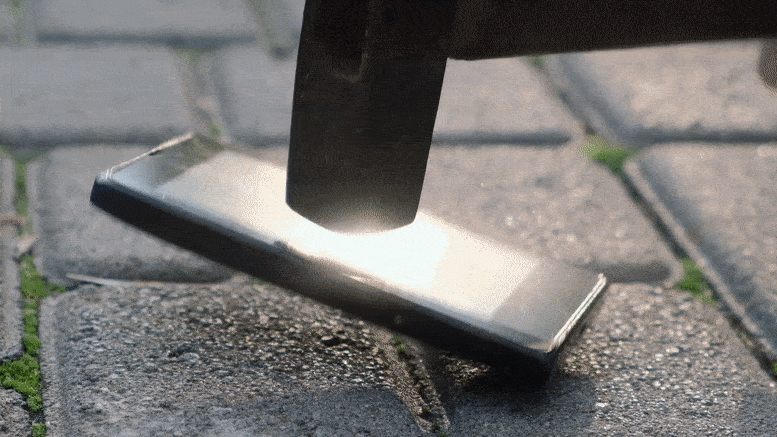
MIT researchers have developed a lightweight, two-dimensional polymer that is stronger than steel, easily producible in large quantities, and could be used for durable coatings or structural materials. (Stock video to illustrate the concept of a super strong cell phone.)
The new substance is the result of a feat thought to be impossible: polymerizing a material in two dimensions.
Using a novel polymerization process, MIT chemical engineers have created a new material that is stronger than steel and as light as plastic, and can be easily manufactured in large quantities.
The new material is a two-dimensional polymer that self-assembles into sheets, unlike all other polymers, which form one-dimensional, spaghetti-like chains. Until now, scientists had believed it was impossible to induce polymers to form 2D sheets.
Such a material could be used as a lightweight, durable coating for car parts or cell phones, or as a building material for bridges or other structures, says Michael Strano, the Carbon P. Dubbs Professor of Chemical Engineering at MIT and the senior author of the new study.
“We don’t usually think of plastics as being something that you could use to support a building, but with this material, you can enable new things,” he says. “It has very unusual properties and we’re very excited about that.”
The researchers have filed for two patents on the process they used to generate the material, which they describe in a paper published in Nature on February 2, 2022. MIT postdoc Yuwen Zeng is the lead author of the study.
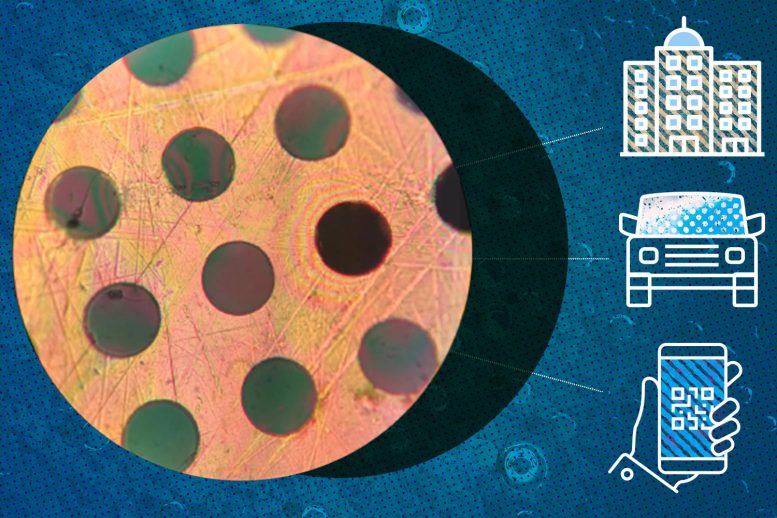
The new material is a two-dimensional polymer that self-assembles into sheets and could be used as a lightweight, durable coating for car parts or cell phones, or as a building material for bridges or other structures. Credit: polymer film courtesy of the researchers; Christine Daniloff, MIT
Two dimensions
Polymers, which include all plastics, consist of chains of building blocks called monomers. These chains grow by adding new molecules onto their ends. Once formed, polymers can be shaped into three-dimensional objects, such as water bottles, using injection molding.
Polymer scientists have long hypothesized that if polymers could be induced to grow into a two-dimensional sheet, they should form extremely strong, lightweight materials. However, many decades of work in this field led to the conclusion that it was impossible to create such sheets. One reason for this was that if just one monomer rotates up or down, out of the plane of the growing sheet, the material will begin expanding in three dimensions and the sheet-like structure will be lost.
However, in the new study, Strano and his colleagues came up with a new polymerization process that allows them to generate a two-dimensional sheet called a polyaramide. For the monomer building blocks, they use a compound called melamine, which contains a ring of carbon and nitrogen atoms. Under the right conditions, these monomers can grow in two dimensions, forming disks. These disks stack on top of each other, held together by hydrogen bonds between the layers, which make the structure very stable and strong.
“Instead of making a spaghetti-like molecule, we can make a sheet-like molecular plane, where we get molecules to hook themselves together in two dimensions,” Strano says. “This mechanism happens spontaneously in solution, and after we synthesize the material, we can easily spin-coat thin films that are extraordinarily strong.”
Because the material self-assembles in solution, it can be made in large quantities by simply increasing the quantity of the starting materials. The researchers showed that they could coat surfaces with films of the material, which they call 2DPA-1.
“With this advance, we have planar molecules that are going to be much easier to fashion into a very strong, but extremely thin material,” Strano says.
Light but strong
The researchers found that the new material’s elastic modulus — a measure of how much force it takes to deform a material — is between four and six times greater than that of bulletproof glass. They also found that its yield strength, or how much force it takes to break the material, is twice that of steel, even though the material has only about one-sixth the density of steel.
Matthew Tirrell, dean of the Pritzker School of Molecular Engineering at the University of Chicago, says that the new technique “embodies some very creative chemistry to make these bonded 2D polymers.”
“An important aspect of these new polymers is that they are readily processable in solution, which will facilitate numerous new applications where high strength to weight ratio is important, such as new composite or diffusion barrier materials,” says Tirrell, who was not involved in the study.
Another key feature of 2DPA-1 is that it is impermeable to gases. While other polymers are made from coiled chains with gaps that allow gases to seep through, the new material is made from monomers that lock together like LEGOs, and molecules cannot get between them.
“This could allow us to create ultrathin coatings that can completely prevent water or gases from getting through,” Strano says. “This kind of barrier coating could be used to protect metal in cars and other vehicles, or steel structures.”
Strano and his students are now studying in more detail how this particular polymer is able to form 2D sheets, and they are experimenting with changing its molecular makeup to create other types of novel materials.
Reference: “Irreversible synthesis of an ultrastrong two-dimensional polymeric material” by Yuwen Zeng, Pavlo Gordiichuk, Takeo Ichihara, Ge Zhang, Emil Sandoz-Rosado, Eric D. Wetzel, Jason Tresback, Jing Yang, Daichi Kozawa, Zhongyue Yang, Matthias Kuehne, Michelle Quien, Zhe Yuan, Xun Gong, Guangwei He, Daniel James Lundberg, Pingwei Liu, Albert Tianxiang Liu, Jing Fan Yang, Heather J. Kulik and Michael S. Strano, 2 February 2022, Nature.
DOI: 10.1038/s41586-021-04296-3
The research was funded by the Center for Enhanced Nanofluidic Transport (CENT) an Energy Frontier Research Center sponsored by the U.S. Department of Energy Office of Science, and the Army Research Laboratory.

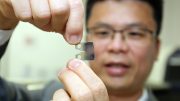


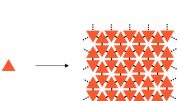



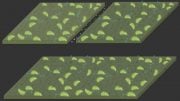
what is the melting point?
This is a highly crosslinked polymer, so it probably degrades before melting. Additionally, polyaramids like these tend to have higher phase transition points than most other polymers.
The fact that no one realizes they just created “vibraniun” 🤣
Super well written and easy to follow for armchair scientists like me. Thanks!
If the new material is truly stronger than steel I wonder how will manufacturers of various parts for cars, airplanes and cell phones for example be molded into specific shapes? What tools would be required to cut such material into the desired shapes for various consumer products? Or is the hardening polymer applied after the the material is already cut to its specific measurement?
Highly uninformed reporting to mislead general public who are not expected to know the mechanical properties of most materials. This is a shame on the part of the article’s author. Bad publicity. Ask the authors or read the Nature article. MIT should take steps against this kind of publication and the authors of such uninformed journalists.
Note that they reference A36’s value for the yield strength of structural steel for their comparison — this is a soft steel in comparison with some alloys and treatments of steel.
Oh, goody.
More plastics.
My thoughts exactly. How do we * get rid of it* after it has served its intended use?
Well there is a term for that, Recycling. But western society needs to start using that term and implementing it and not trying to “recycle” our polymers back to China..
These plastics aren’t gonna be used for soda bottles or food containers. Did you even read the article?
So…plastics aren’t bad for the environment?
These plastics aren’t gonna be used for soda bottles or food containers. Did you even read the article?
The plot twist might be that for application as phone screens perhaps it might, on some of chance, be brittle as a plastic? Then, as with all amazing technologies such as every version of Corning’s gorilla glass, will break if you just accidentally drop your phone (assuming this material is used for the screen). Tee hee!
Plastic is not brittle its the far opposite of that, it’s too soft. Gorilla glass is glass, glass is very brittle but very hard, hence phone screens do not scratch easily.
So if they want to use this as a screen, the issue will be in scratches and not shattering.
Look up Motorola’s unbreakable screen.
Modulus of steel is 200 GPa compared to this material’s 12.8 GPa. High strength steels have yield strength in excess of 1400 MPa compared to this plastic’s 488 MPa. 2D materials like Graphene has modulus of >1 Terra Pa and strength of >100 GPa. How does the author of this article claim the superiority compared to existing materials? The authors of the Nature article does not claim what the article says.
nothing works when it -10 C
If nothing works at -10°C then why does the instrumentation on the Webb telescope work at -370°C? In fact they must be at that temperature because they are extremely sensitive in the infrared.
There are some materials that are strong but not brittle at very low temperatures. Not sure but I think it’s called the ‘thermal tensile strength coefficient’.
It’s one of the reasons barium was used for the construction of the primary mirror on the Webb. Barium has exceptionally stable properties at very low temperatures.
I would expect, that if this material is what they claim, its properties are stable over a wide thermal range.
I agree, though I have one correction. The primary mirrors of the JWST are made of Beryllium, not Barium.
James Webb space telescope doesn’t use polymers…jeez!
Tired of stories that mean nothing. Use it or lose it.
Very Good. Exciting Development.
Isn’t Polymer Chemistry Fascinating! Polymers with cross linked Covalent Bonds (which are extremely Strong Bonds) will theoritically be stronger than the Ionic Bonding we are all
highly familier with, like a mixture of Salt ( Sodium Chloride) and Potassium Bicarbonate and other Salts we mix with Water or Juice and give kids playing baseball in the sun, so they dont get dehydrated!!
This is very good at two dimensional level. Was wondering if such materials and polymers can be created at a one-dimensional level. I guess at a Zero Dimensionnal Level Matter would have been will have completely transformed into Energy. I wonder what are the phases in this One to Zero Dimensional Transformation and can we create completely indestructible Material as we approach the Zeroth Dimension. I was wondering if negative dimensions exist and what happens in these dimensions. Are Animatter Polymers Formed? Exendthe logic of Dimensional Matter to Antimatter!
Get a cross functional team together with Physics specialists, Quantum Chemistry & Phhysics Specialists, Nano Chemistry Experts, Biologists and other appropriate engineering and other talent together, to explore the implication, for Polymers like amino acid chains , protiens etc. The possibilities for Health and Medical ScienceProgress is endless.
After all except for the breath of Life, all the rest in a biological species is polymer chemistry at work.
Views expressed are personal and not binding on anyone.
Hemp forms a stronger bond than steel and a lighter weight than carbon fiber but here we are acting like Ford didn’t buy and bury those patents nearly 100 years ago..this is trash. Stop using toxic plastics and focus on organic materials.
If so those Patents are public knowledge and their protections would have expired decades ago.
Do not waste your time replying to someone saying Hemp is stronger than steel and then blaming a company that has nothing to do with steel production as the cause.
Perhaps he meant to say technologies were buried, rather than patents were buried.
And I heard a version where Henry Ford was trying to use such a technology and others were responsible for crushing it.
I’m not claiming to have evidence; just keep in mind that contradiction with your current worldview is also not negative evidence.
I’d be interested to see how it performs as an H2 tank liner coating.
I noticed you’re still working with polymers.
Dr. Nichols : “Still? What else would I be working with?”
Haha. I had the same thought. Could this be the “transparent aluminum” of Star Trek? Seriously, is this polymer transparent?
And what effect of a superstrong plastic have on our oceans, seafood, and air ? Considering the overall mass of nanoplastics on the environment, this must be studied, if not regulated.
If it super strong, as well as water and gas resistant, wouldn’t it be preferable to what we’re already throwing into the ocean?
Ice-9?
Geez, I hope not.
Fungi are the cure for plastics in the environment. We the people just need to demand it from our fearless leaders…😁
Does this material mean we’ll soon have all plastic firearms?
Exactly! 3d printed guns at home that aren’t traceable oh my! 😜😜😜 The liberals are going to have a stroke..
I wonder whether this could be used to produce a new generation of spacesuits. Seems like it could be well suited to the task.
P.S. what’s with all the wackadoodle plastics-are-bad regressives in the comments section? Why do they even read articles about science and engineering if they’re so opposed to it? Just to make themselves angry? 🤦♂️
This is not new. They created JB Weld a long time ago.
Why don’t the entities that funded the research (US taxpayers) own the patents?
Same reason the Pharmaceutical industry makes billions and billions and leaves the public in the dark ages. Uber Capitalist propaganda and greed. The future is Smarter democracies and social-anarchist public owned and operated industry.
Because MIT received donations from big tech companies that want to use their research to make billions. Why do you think they want you to take the shot(we paid billions for) and not use ivermectin, valacyclovir, zinc and vitamin D?
So, MIT created storm trooper armor aka plastisteel? Excellent. Now find other applications for it. Will this stuff resist GCRs? Maybe it could be used by Nasa and space x for cheaper rockets, space suits, death stars? Or on ships? Imagine boats that don’t rust or submersibles that could withstand crush depths over 900 meters. Or maybe it could replace automotive sheet metal by a large percentage. Think Tesla plaid but faster. Or maybe prosthetic body parts. Or Darpa Petmen with skeletons made from this stuff? Get in touch with Dr. Rabenei at ncsu and collaborate on composite metal foam. Maybe the two technologies can be merged. Now get cracking I’m still waiting on evolved miracle materials. I needed poly mimetic alloy yesterday!
What company gets to work with the new material. ,Is it a new oddity that’s forming, Who has the right to patterns. Hoping since is taxpayer funding, we need little clarification.. thank you..
Dupont probably “donated” a couple million fed notes to MIT so they can use the technology and make billions. Same song and dance the pharmaceutical industry performs for things like COVID-19 immune system booster shots..
No mention of fatigue properties.
Even if they compare strength with A36 (1018) which is around 30-40K PSI in a not heat treated state, this translates to ~60K PSI… For plastic, that’s an incredible number! Teflone, for example, has 2K PSI strength. Polyurethane – up to 5K PSI only.
Can this material be used to produce energy? I would think material could be used to coat public roads to capture solar and produce energy and eliminate giant solar fields.
“MIT postdoc Yuwen Zeng is the lead author of the study.” Which means the CCP already has all of the research and data.
Good God, can you be more racist!
Chinese is a nationality. Not a race. Humans are a race.
Attacking whole cultural identity and grouping individuals into non-thinking non-feeling labels makes you a fascist Nazi. If you disagree you are just an ignorant mini tyrant. Who’d take you seriously? Only a Mother could pretend to accept such faults. Please 🙏 leave the comments section to better evolved persons.
Apparently you think the Chinese Communist Party is an Ally of the US and that they haven’t been sending students to gain education in the west for decades so they can steal our technologies..I’m not woke or have ill feelings against the Chinese, I just read about how they are stealing our technology from educational institutions.
Chinese is a nationality, Asian is a race, Human is a species, woke is a neuroses.
There isn’t a “race” section in taxonomy..
Further, he said CCP not “people of Chinese heritage”.
I swear these days you couldn’t throw a white guy far enough to avoid hitting someone looking for any possible angle to point and shout “racist” at you without even thinking it through.
It’s time they just declare “woke” a religion of neurotic white people at this point.
Pull your head out of woke behind. You are a fool if you believe that the Chinese Communist Party does not already know about, and have access to, the information and research discussed in this article.
Be sure there is no security to protect this so that China, Russia, and a other adversaries can steal this intellectual property and use it against us.
This may be the most important advancement a century. It literally changes everything.
I said that after every science/tech article I read for about five years before reality smacked me in the face and informed me that breathlessly exuberant articles about a breakthrough are essentially 1 in a 1000. Almost none of those thousands of articles have been a breakthrough for one piece of context or another.
Let’s just say it looks promising and has a lot of potential. 😉
Why so many Chinese involved in this polymer thing? Just asking for a friend.
Have your friend Google :”Thousand Talents Plan”
Aliens already did this..
Hope this isn’t made from Petroleum, the green fascists want to eliminate that.
Them ornamentals sure are clever.
😂😂😂😂😂🤣🤣🤣🤣💗
Already stolen IPR by China,,,next.
I recall in Star Trek there is a scene where Scotty divulges the secret to making transparent aluminium. Science imitates art it would seem. Transparent steel is amazing.
MIT postdoc Yuwen Zeng……………
So the Chinese have already stolen it then, got it.
Is it going to be proprietary or is it going to be shared with the Chinese?
They already know..
Leftist will at first live it. Then a realization will set in. You can’t make this or any other plastic without oil. The cognitive dissonance will make their heads explode.
Can we just once please assure that this technology won’t be stolen by the Chinese?
Transparent aluminum, as was predicted in Star Trek III with the whales.
Star Trek referred to this as “transparent aluminum “
It’s an article celebrating a scientific breakthrough. This is not the place to post negative comments. Make your own website or blog if you insist on sharing your negative opinions. The bigotry is totally unacceptable. I am having difficulty understanding how the assumption that just because the main author of the research and some of the other researchers have Chinese names they are automatically sharing the research with China. That’s totally absurd. So based off of that logic nobody with a Chinese name has ever been born somewhere else other than China, and every person with a Chinese name has direct connection with the Chinese government and scientists in China just in case they are ever part of any ground breaking research, any scientific breakthrough, or any major scientific discovery that’s not made in China they can quickly share the information with China? And so what if the research is shared with China. God forbid that a Chinese scientist uses this research to develop some type of medical device that ends up saving the life of a parent, a child, or even your own.
Simmer down, Senor Chang.
The Chinese Communist Parties military is pretty excited about the many military uses this will have.
A 2D polymer?
Here’s hoping we get scaled up plastic-toy-car-strength in a full sized automobile.
Can it pass California regulation? How long before cancer develops?
OMG! “Everything” is probably cancerous in California…
‘ñuff said!
That’s what ET has been making their UFOs out of. They’re not going to be happy that we figured out how to make it.
Nice! Make one of these, please:
https://en.wikipedia.org/wiki/Vacuum_airship
This could help with getting weapons through metal detectors. Love it!!!
Fantastic invention. Could be used for dental applications? Is there any future downside to 2DPA-1? Is it fileable? How would the appropriate people dispose of pieces of it? What could cause it to decompose to “go back to nature?” Just wondering about this new invention’s parameters.
Hmmmm, sounds like graphene oxide/graphene hydroxide. Nano size, can be added to a solution, self assemble and strong enough to withstand passing through a needle and the human body. Oh, and it’s indestructible. Good luck detoxing that shot!
If it is stronger than steel and does not degrade quickly, this could change a lot. Mostly if it can be molded. Possibly make cars lighter and yet safer, a better gas mileage. The lighter weight may allow the ability to make flying vehicles too.
“Yuwen Zeng is the lead author of the study.” I guess the Chinese will have this to market before us.
So, sounds like someone actually invented the plasteel from “Dune”…
Transparent aluminum
After the Democrats eliminate oil and gas production, where will they get the stuff to make this?
Can you make a large coil of the material and form and stamp parts in a press like steel? Or would it have to be like injection molding?
–
TRANSPARENT ALUMINUM
–
So, if the football team jumps through it after half time, how does that go?
Have the Chinese stole it yet?
if you read the article carefully, the lead scientist for this is a Chinese
I can’t help but suspect that none of the conspiracy touting xenophobic wackjobs have ever, in their whole life, made a productive contribution to society. But congratulations on being a white (European) immigrant, you have so much to be proud of. I didn’t realize being white gave me the authority to dismiss the rest of humanity.
Well…now you know.
Well then, make Masks for Politicians…Air Can’t penetrate, Good Job…
LOL
Pepepopo
But does it cause cancer in California?
Just what we need. Xing ping to write home about it and Biden will willingly hand it over to the people’s republic
Confused about the hydrogen bonds that are mentioned since hydrogen only has one electron to bond with and if it’s part of a polymer it’s bonded to the carbon backbone. So you might be talking about van der Waals or weaker bonds I guess right? Many polymers use cross-linking for copolymers can be formed into a semi-crystalline material which is going to be much stronger than such bonds I think what you’re trying to say is this is if in film that has great strength and potential for impermeability but I don’t see how this could be a building block for a three-dimensional material without additional cross-linking or crystal entity from some other molecule. It’s all very interesting but I’m not sure if it’s contextualized accurately here.
The title of this article makes it sound like they invented Vibranium.
I like to know how resistant it is to UV (sunlight). Plastics, like my patio furniture, degrades over time in the sun.
Is this stuff recyclable?
Reverse engineering of uap technology this has been around since the 70s and just coming to surface 😂😂😂
Highly uninformed reporting to mislead general public who are not expected to know the mechanical properties of most materials. This is a shame on the part of the article’s author. Bad publicity. Ask the authors or read the Nature article. MIT should take steps against this kind of publication and the authors of such uninformed journalists.
Plastics can be made from hemp and / or bamboo, no petrochemicals needed. We need to start making tiny houses that can better withstand: floods, tornados, hurricanes, lightning, UV rays, etc. Making buildings out of plywood and 2×4’s coated in this stuff might make them as strong as concrete and steel.
I like how you avoid calling it was it is, plastic. Stop infoscamming people!
Great! Now how about a grease based”Graffiti” DISSOLVING paint for public buildings.
Also, why cannot we learn from civilizations from the past and just stick to brick and mortar? I appreciate the strength of newly discovered materials for bridges etc. But the new materials being used to for new offices, living spaces look to weather and age horribly.
I love brick and mortar. All shades.
Interesting that noones commented on the sponsoring. Namely the US military one. From which I find it highly unlikely that any participants weren’t rigorously classified before inclusion. So anyone saying that it’s Chinese by default of it’s scientists is ignorant. What should be concerning if not alarming is the military s desire for this technology’s creation
Calling dibs on “Poly-Impossibli-AshardasSteel-plastic”
read about this a few months ago its not even plastic….try more like graphite, but reduced to its simplest form then is able to connect for structure plus formed into shape by placing it into a polymer. so think about the new age of 3D printing just now since the world is going paperless now we have a use for all those pencils.
How do I delete this website!